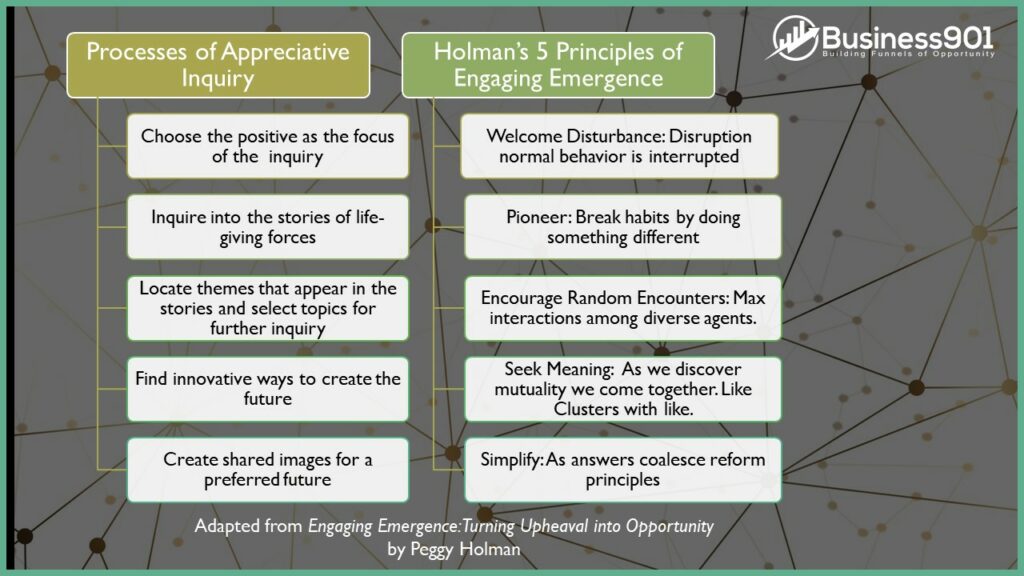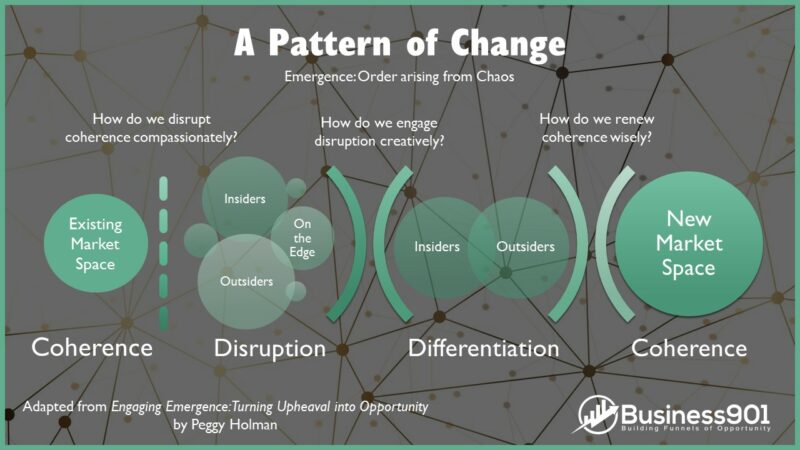If your organization and specifically, your sales and marketing teams are not in the practice of Engaging Emergence, what chance does your brand have in the race for innovation and new markets? So, what is Emergence? From Peggy Holman’s book Engaging Emergence, Turning Upheaval into Opportunity, 2010, Holman says,
I define emergence as simply as possible: order arising out of chaos. a more nuanced definition is higher-order complexity arising out of chaos in which novel, coherent structures coalesce through interactions among the diverse entities of a system. Emergence occurs with these interactions disrupt, causing the system to differentiate and ultimately coalesce into something novel.
I have adapted Holman’s Pattern of Change diagram for use from a sales and marketing point of view. However, I want to emphasize that emergence is seldom manipulated, and as I often put deterministic. It is much more organic than we may care to believe. We certainly can create more opportunities to engage, recognize, and realize the benefits of it, but it can also be elusive. It takes practice, patience, and maybe the hardest trait, acceptance.
We define our marketing space as our current state, our place of comfortability. Within that space, we can shift incrementally without too much effort and risks. However, the idea is to create new opportunities, new markets, not the same old ones that you continue to fight for market share.
Most people think of increasing revenue by competing with the competition or finding more target customers. I don’t think that you can significantly increase market share by continuing appealing to similar people in the same way and especially not by directly competing with entrenched competition. In fact, you are probably already doing that with mediocre results. To make a significant leap in sales even by increased advertising means you will probably have to outspend them or make an offer that someone can’t refuse. Neither is beneficial to the bottom line.
If you think of that space as a room with doors, our typical marketing process is to invite people in through existing doors. In emergence, we are looking for the invisible doors. Ones that we may not be even aware but we as insiders and outsiders may even sense are there. From the book, The Art of Relevance by Nina Simon, she describes this phenomenon from a perspective of insiders and outsiders.
There are two kinds of people in the world of relevance outsiders and insiders. Insiders are in the room. They know it, love it, protect it.
Outsiders don’t know your doors exist. They are uninterested, unsure, unwelcome. If you want new people to come inside, you need to open new doors—doors that speak to outsiders— and welcome them in.
Simon goes on to explain outsiders and the invisible doors:
For most people on the outside, the doors don’t even exist. Any door will always be invisible to some. There will always be some people who pass by your place unseeing, uninterested, unable to engage. That’s fine. The goal is not to open doors to everyone. We don’t always choose what doors we see. The world chooses—in ways both beautiful and hideous, based on circumstance as much as individual will. It may take an activist to open new doors and pioneer new pathways of relevance.
The problem most of us face is that we view the world from the inside. Even when we move to the outside, we focus on our products and services. It is difficult to find emergence from that point of view. Present Sales and Marketing practices are still in the hierarchy type of thinking. Though they still have some merit for discussion, the days of Bain’s RAPID and even the Challenger Customer Frameworks are sliding into obsoletion. I often struggle to identify those roles, especially from afar. The idea of the decision by committee with concerns of implementation, adoption, and integration has a different structure being developed. The idea of what roles are needed for a balanced change is starting to surface in my work.

At first glance, it may not seem to fit with the processes of Appreciative Inquiry, but I believe AI is at the heart of engaging emergence. Welcome Disruption and Pioneering can seldom happen effectively from a perspective other than one of trust and positivity. Encouraging random encounters reminds us to consider the diverse involvement of people. Seeking appreciative meaning provides a pathway for understanding and innovation. And simplifying is through shared images for coherence.

Many of our sales efforts are integrations that spread over many parts of an organization and in some instance, across our customer’s customer. Our efforts are centered around tools when they should be centered around conversations. From the book, Dialogic Organization Development by 2015 by Gervase Bushe and Robert Marshak, they state,
The Three Core Processes of Organizational Change in Dialogic OD
1. A Disruption in the Ongoing Social Construction of Reality Is Stimulated or Engaged in a Way That Leads to a More Complex Reorganization
2. A Change to One or More Core Narratives Takes Place
3. A Generative Image Is Introduced or Surfaces That Provides New and Compelling Alternatives for Thinking and Acting
On the macro level, I view this as how we would introduce and amplify emergence to our marketing space in conjunction with Holman’s Pattern of Change. This coincides very closely with my idea of what some people may term a sales funnel or marketing funnel. In lieu of those funnels, I am looking at how to approach a more collaborative structure integrating new processes/services within a customer. Stemming from the SD-Logic thinking, that there is no value created until a product/service is used.

However, reversing the subject headings, I think offers a clearer distinction at the micro-level.

These practices need to be vetted out further. They have only been tried in isolation of each other. I believe though they form a solid starting point for building an emergent process.
Book References:
- Engaging Emergence: https://amzn.to/31d7zY6
- Dialogic Organization Development: https://amzn.to/2YFaC9L

